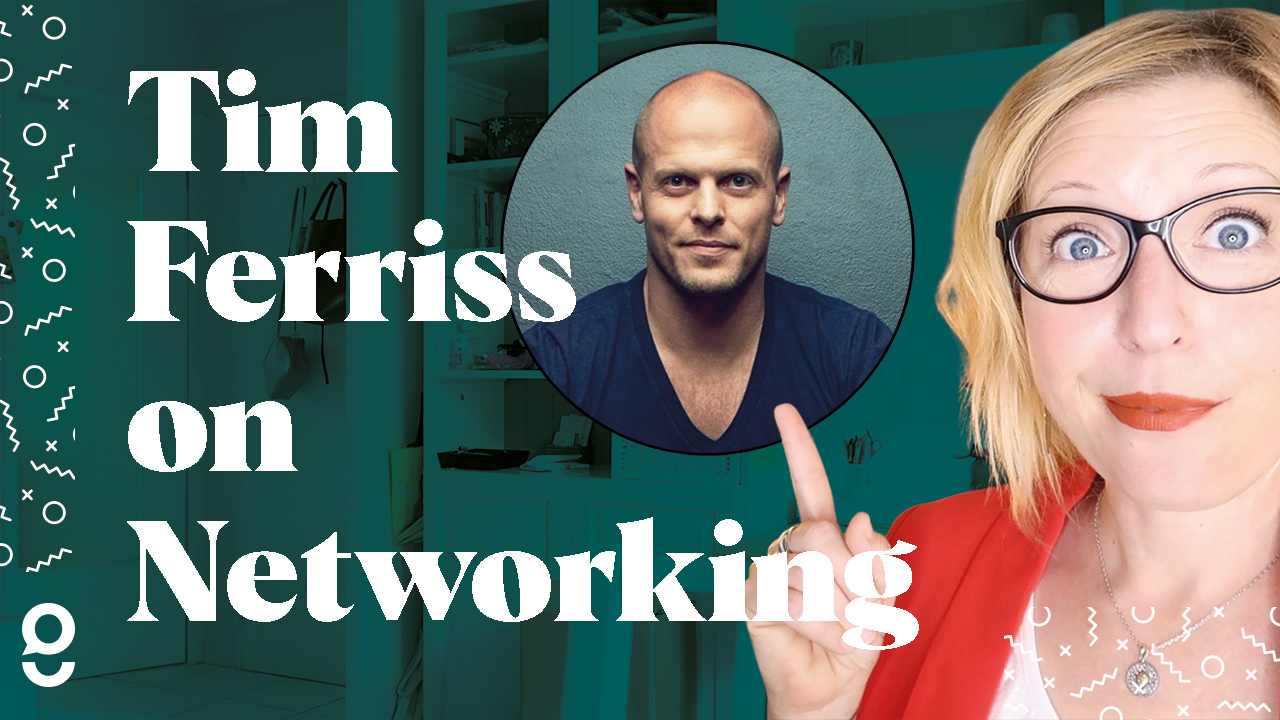
You’re at a networking event…and you’ve got to join a group of people and start a conversation! That can be stressful–especially if you’re an entrepreneur promoting your business…in English! Today, I’ll share some takeaways just for you from Tim Ferriss’s podcast “How to Build a World-Class Network in Record Time.” It’s full of the kind of great advice you can access–when your English is good enough to be a tool to grow your business.
The entire podcast is over an hour long and is one of my favorites on this topic. But don’t worry, you don’t have to watch the whole thing in English right now. I’m going to share some of the best tips today–especially for entrepreneurs doing business in English. I’ll also give you some useful expressions in English so you can start networking while you’re working on your English.
You can find the link to the complete podcast and the transcript in the notes in our comments section. And I’ve got a quiz for you at the end of the post as well!
Ready for some surprising networking tips? Read on!
If you’re an entrepreneur you need these emails!
I asked 30,000 entrepreneurs about the emails they need NOW to grow their businesses. Then I wrote those emails in English. Get my 8 must-have emails for your business here.
What you’ll learn in this article:
1. Networking in English is not what you think: and that’s a good thing!
2. Two rules to remember for networking (according to Tim Ferriss).
3. Ferriss’s advice on how to join a group at a networking event + What to actually say!
4. QUIZ YOURSELF ON TODAY’S LESSON
1. Networking in English is not what you think: and that’s a good thing!
What I love about Ferriss’s perspective on networking is that it is something very manageable. It’s something you can do. Here’s what he has to say: “You don’t have to meet everyone like a robot, you just need one good human connection with someone who can change your life.”
That’s great news for those of us who network in more than one language, or who feel nervous just talking about ourselves. Or if you feel like you don’t ‘know everything.’
As Ferriss puts it “Ignorance is bliss.” In other words, sometimes we’re happiest when we know less!
In fact, he shares a typical example of the way in networking asking questions helps conversations grow–but acting like you know everything or like you’re an expert actually stops conversations (and connections).
2. Two rules to remember for networking (according to Tim Ferriss).
As an entrepreneur doing business in English, I think you’re also going to love Ferriss’s rules for networking. They’re great in general. But they’re essential for all of us doing business in more than one language.
Here’s the first one:
“Don’t dismiss people: treat everyone like they’re important–because they are.”
That simply means you should remember that everyone is someone who can help you.
The second rule is don’t rush when making connections at events.
Remember–you just have to make one human connection. You just have to meet one person and have a good conversation…for it to potentially change your business.
The rule “don’t rush” means take the time to get to know people. Don’t try to ask for something too soon, relax, chat and connect.
If you’re an entrepreneur doing business in English your time is precious. Use strategies that work to help you learn English fast when you get the English Habits Starter Kit I created just for entrepreneurs and business owners.
3. Ferriss’s tips for joining a group at a networking event.
Ok, so if you’ve ever been to a big conference or networking event, you know that joining a group is well, scary. How do you just walk up to people? How on earth do you start talking to them? And in English!?
Yipes!
Here is the Ferriss technique (with a few expressions I’ve added for you–from one bilingual business owner to another).
First, know when NOT to join a group.
Ferriss’s advice is, if you see two people “deep in conversation” don’t interrupt! What does it look like to be deep in conversation? It means to be talking intensely, and very focused.
According to Ferriss, the best groups to approach will have three to four people talking.
What to say when you ask to join a group?
When you find a group you’d like to join, just ask if you can listen for a while.
Ferriss recommended saying something like this:
“Hi there, I’m new here and I don’t know anyone yet. Do you mind if I just hang out here and listen in on your conversation?”
It’s kind of impossible to say “no” to that request politely. But it’s still polite to ask.
And it can look strange if you just start hanging around a group without saying anything!
So…what should you actually say during the conversation?
Remember that advice from earlier: “don’t rush” and “ignorance is bliss?”
Well, now you wait. You truly listen. And when something that really interests you comes up, you ask a good question about it to learn more.
What kind of question? Try one of these:
If the person you’re listening to is talking about an important choice the company made to work with a new web developer you could say:
“Now, I’m not in tech, so I don’t know much about how to pick the best developer, but I’m curious… Why is that the best choice?”
Remember, the goal is to ask questions that get people talking, not to show you know something or state an opinion.
Or maybe the person is in the coaching industry and is saying they just started offering their coaching program in English for the first time. You could say:
“So I have a question–I’m not in the coaching industry, but I’m curious. What made you decide to start doing coaching in English?
Notice that both of these questions have to do with the conversation that was going on before. They don’t offer an opinion or expertise.
They offer a chance for more discussion, and for the other person to share their knowledge with you!
Then wait patiently and introduce yourself briefly.
Ferriss is serious about not rushing things and being patient. His advice:
Continue to listen, ask good questions, and wait to see if someone asks you a question.
For example, someone might ask you:
“Hey, what do you do exactly?” (What’s your job, position, role in your company).
You’ll give a very short answer.
Here’s the example like the one Ferriss gives in his podcast (what he would say):
“I’m new here. I just published a book and I can’t figure out how to promote it–I’m trying to solve that problem.”
(Here, figure out means to understand, determine)
What’s YOUR Ferriss introduction for your next networking event?
I like that introduction because if anyone is interested, they’ll ask about your book or your business. Or they’ll offer to help you.
Spending too much time talking can lead to awkward pauses in the conversation–so it’s smart. AND it’s less work for you.
So what does your shortest possible introduction look like?
What problem are you trying to solve?
Try making your own super short introduction.
Start with what you just did: (A recent accomplishment, step you’ve taken etc)
“I just…(and then fill in your answer here)
- started a company
- launched a new product
- developed a new software program”
Then say what you’re trying to do next.
“And now I’m trying to figure out how to…
- promote my business,
- reach a wider audience,
- find international clients…”
Your answer depends on you and your business of course. And that’s where it can get a little more difficult–I know, from experience attending lots of conferences in French. So here are some ideas to help you:
Your Next Steps to Get Ready to Network!
First, of all–did you know I occasionally offer free masterclasses for entrepreneurs on networking, small talk, and growing your business in English? If you want an invitation to the next one be sure to sign up for my newsletter today.
Then take this week’s quiz
QUIZ YOURSELF ON TODAY’S LESSON
And now take this week’s quiz to see if you remember those great lessons from Tim Ferriss about networking.
#1 Which of these is really one of Ferriss’s rules for great networking at events?
- Talk to EVERYONE!!
- Don’t dismiss anyone.\
- Be the expert.
#2 What does “ignorance is bliss” mean in networking?
- It’s ok not to know all the answers.
- It’s important to ask good questions.
- When you don’t know something, it can start a conversation.
- All of the above=all these answers.
Improve your English in the comments:
And if you don’t use it, you lose it! So here’s your chance to practice your super short “Ferriss introduction”.
Remember the structure?
I’m new here. I just____________and now I’m trying to figure out how to__________.
Here’s your Confidence Challenge for this week:
- Leave your own introduction in the comments.
Further reading for entrepreneurs in English
Curious to learn more about the topic of the day? I’ve selected this excellent resource for you. It helps native speakers be great at networking–and it’ll help you too!
- Tim Ferriss’s podcast: How to Build a World-Class Network in Record Time
- And the transcript.
Are You an Entrepreneur Who Needs English for Your Business? Then you need these emails!
We asked our community of entrepreneurs about the emails they need to send NOW to grow their businesses. These are the emails they need to make new contacts, and turn them into clients…or maybe just get paid for the work you did!
We also asked our entrepreneurs what business emails were the hardest to write.
Then, we created 8 perfect email models so that you can write an email that is effective and polite–fast. Because you need email to start a conversation with your international clients.
And because you shouldn’t have to spend an hour writing an email in English–and then wondering if you said that right.
Get “8 Must-Have Emails for Entrepreneurs–in English.”
…and write emails that can change your business today.
Christina
More good stuff…
Click the image to learn more








Answers to Today’s Quiz:
#1 Which of these is really one of Ferriss’s rules for great networking at events?
Don’t dismiss anyone.
#2 What does “ignorance is bliss” mean in networking?
All of the above=all these answers.